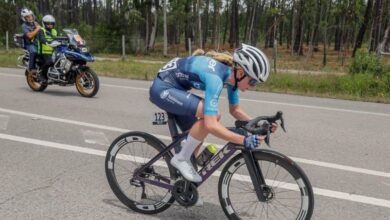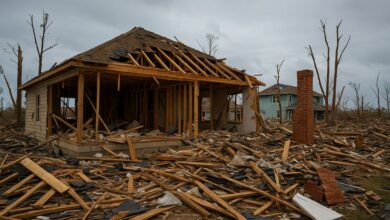Why Murcia should be on every gravel rider’s winter list – Yellow Jersey

Getting there
The region around Murcia was a blank canvas for me. Nestled in the southeast of Spain between Valencia and Malaga, it has a great network of greenways on former railway lines, which helped me map an initial route for a 5-day bikepacking trip.
I used the cities of Cartagena and Murcia as start and finish points; both are well connected by train. In between is Caravaca de la Cruz, one of only five holy cities in the world, which would be a great midway point to add some culture to the trip. With the help of Jose Peran and the local tourist board of the Region of Murcia I planned a trip to explore this beautiful part of Spain further.
Travelling to Cartagena was hassle-free. I packed my Kinesis Tripster AT gravel bike in a cardboard box and took it with me. The bike is my first choice for most of my travels, as the aluminium is less fragile. Expecting some rough gravel tracks, I fitted a new set of Schwalbe Overland tyres, which have served me well on my recent travels in Scotland, Canada and Norway.
As her e-cargobike wouldn’t be allowed on a plane, Louise hired an e-bike locally from The Osados, Jose’s company. The Lapierre E-Explorer was a good choice for the trip, with chunkier tires and enough battery for most days. Both of us had bags from the Carradice Adventure Range, and I used Apidura’s Racing Series for an additional frame and top tube bag, as well as their Hydration Backpack, which is my go-to choice for carrying my camera equipment.
The closest international airport with direct flights to Edinburgh was Alicante, served by Ryanair and Jet2 with frequent connections. Jose gave us a lift in his van to Cartagena, where we spent the first night at the Sercotel Alfonso XIII Hotel. If you travel by public transport, then starting in Murcia is the better choice, as the regional capital has frequent bus and connecting train services to and from the airport. Getting from Murcia to Cartagena by train is super easy, and compared to UK fares, cheap as well.
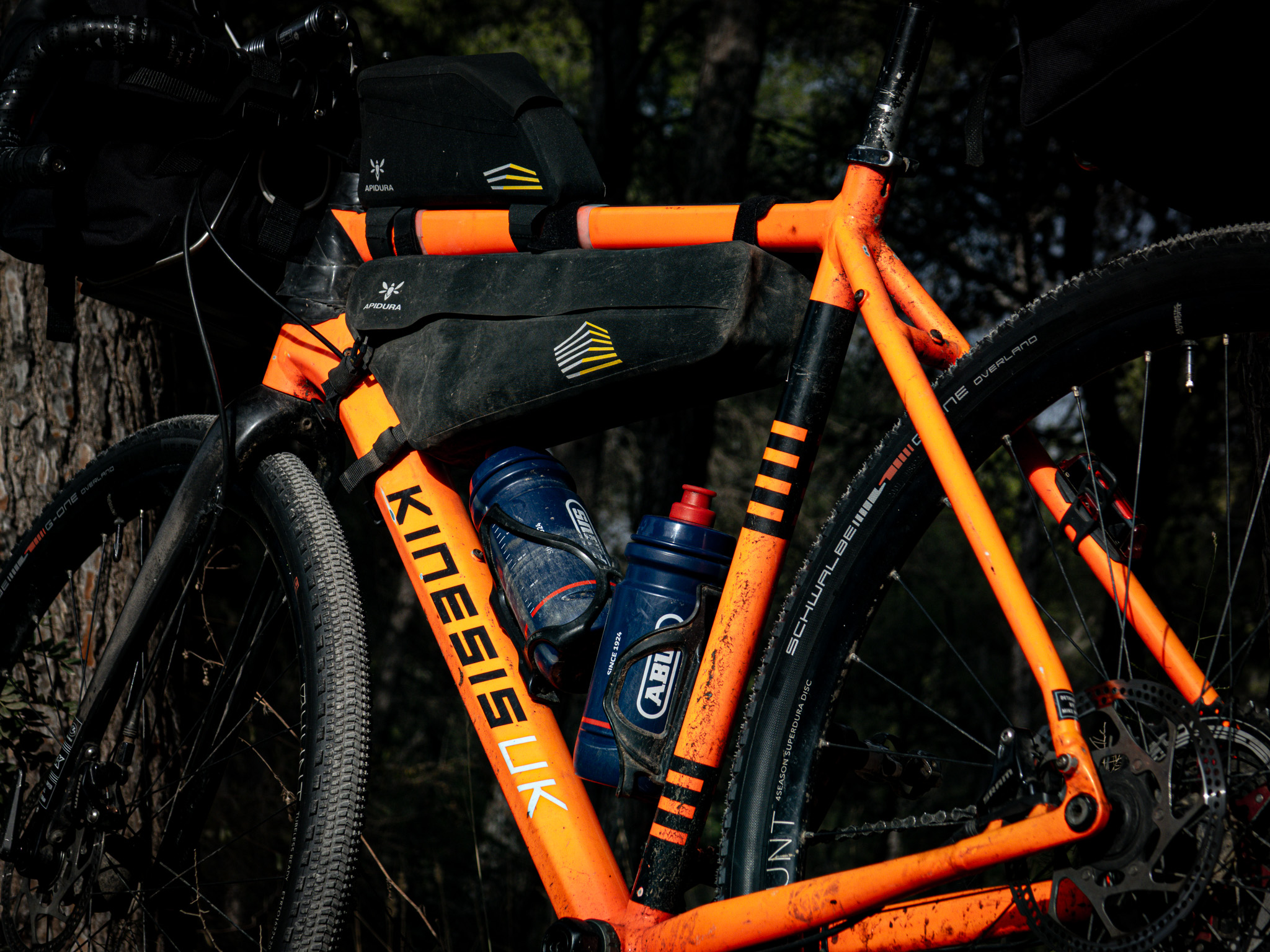
setting off into the heat
After a healthy breakfast we were off. For two people used to Scottish summer temperatures it was still very warm at the end of September, but the cloud cover on the first day helped us to cope well with the hot weather on our way from Cartagena to Aledo. With 1,300m of climbing packed into 86km this was the toughest day of the journey, so sadly we didn’t have enough time for a proper visit to the second largest town in the region.
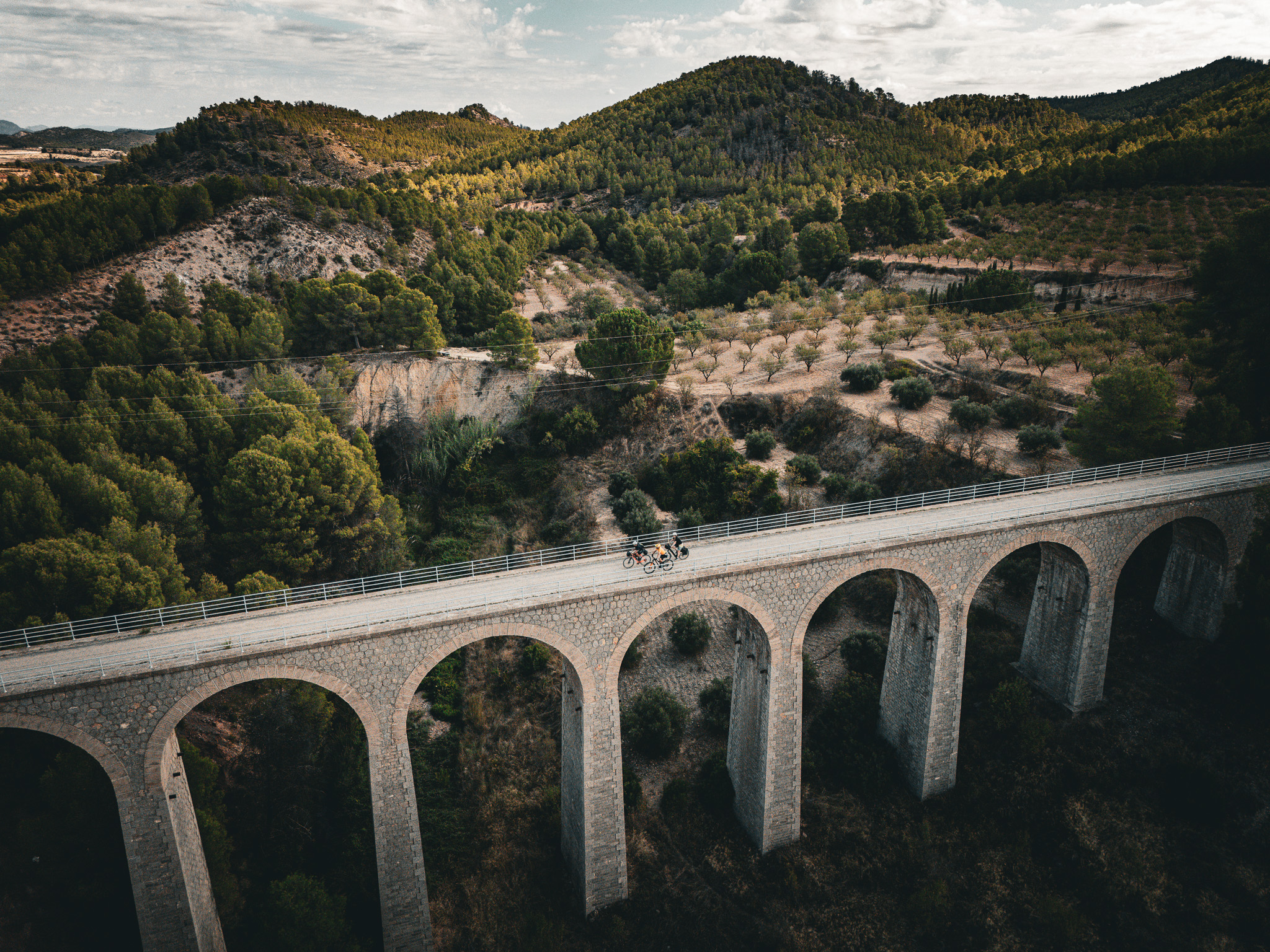
Soon after leaving the city boundary, we found ourselves in the Parque Regional Sierra de la Muela, Cabo Tiñoso y Roldán – a coastal natural area with a multitude of trails, diverse wildlife species and striking views. Both of us were looking forward to warm summer temperatures and a break from the recent weeks of heavy rain in Scotland. And this was exactly what this trip delivered as soon as we hit the trails. Like in Scotland we still had most of the routes completely to ourselves. The riding provided everything from more technical singletrack sections to smooth gravel roads. Unlike in our home though, the sections on tarmac were enjoyable as well, as drivers in Spain are very accommodating to cyclists.
The Cafe-bar El Rincon del Retal in Las Palas was our first lunch stop, serving a very delightful Paella and excellent coffee. Next to great cycling routes, food is the second most important ingredient for a successful bikepacking trip for me, and the Region of Murcia delivered on this. As one of Europe’s largest growers of fruits, vegetables, and flowers, and host to important vineyards, the area has no shortage of great local produce. Between the more mountainous and barren uplands we cycled through olive groves, past wine plantations, and almond trees.

About halfway through the first day we joined the Campo de Cartagena Greenway, one of the many greenways in the region. Imagine riding on a super smooth straight gravel track for about 15km – a paradise to cycle. On the edge of the greenway, we spotted loads of chupaeros. Those small snails, which are growing in orchards, especially in fennel fields, are typical for the cuisine of the Region of Murcia, although harvesting them in the wild is banned.
We filled up water bottles and swapped bikes in Totana, as the frequent climbs had taken their toll on Louise’s battery, which was now at 3%. Although the final climb of the day to Aledo was mostly on tarmac, it was about 10km long and very steep in sections. Drawing on experience from my singlespeed past, I cycled most of it without assistance. Both of us were relieved when we arrived at the Mirador de Aledo Hotel in the dark after the first day in the saddle.
Another great thing about bikepacking in Spain: Late arrivals don’t present a problem at all. At 8pm we were greeted with a warm welcome by the hotel owner, and an hour later we were the first guests to be treated to a three-course meal and a wonderful bottle of white wine. Sitting outside in 22 degrees, looking at a sky full of stars, palm trees and savouring delicious seafood, we were more than happy with our journey.
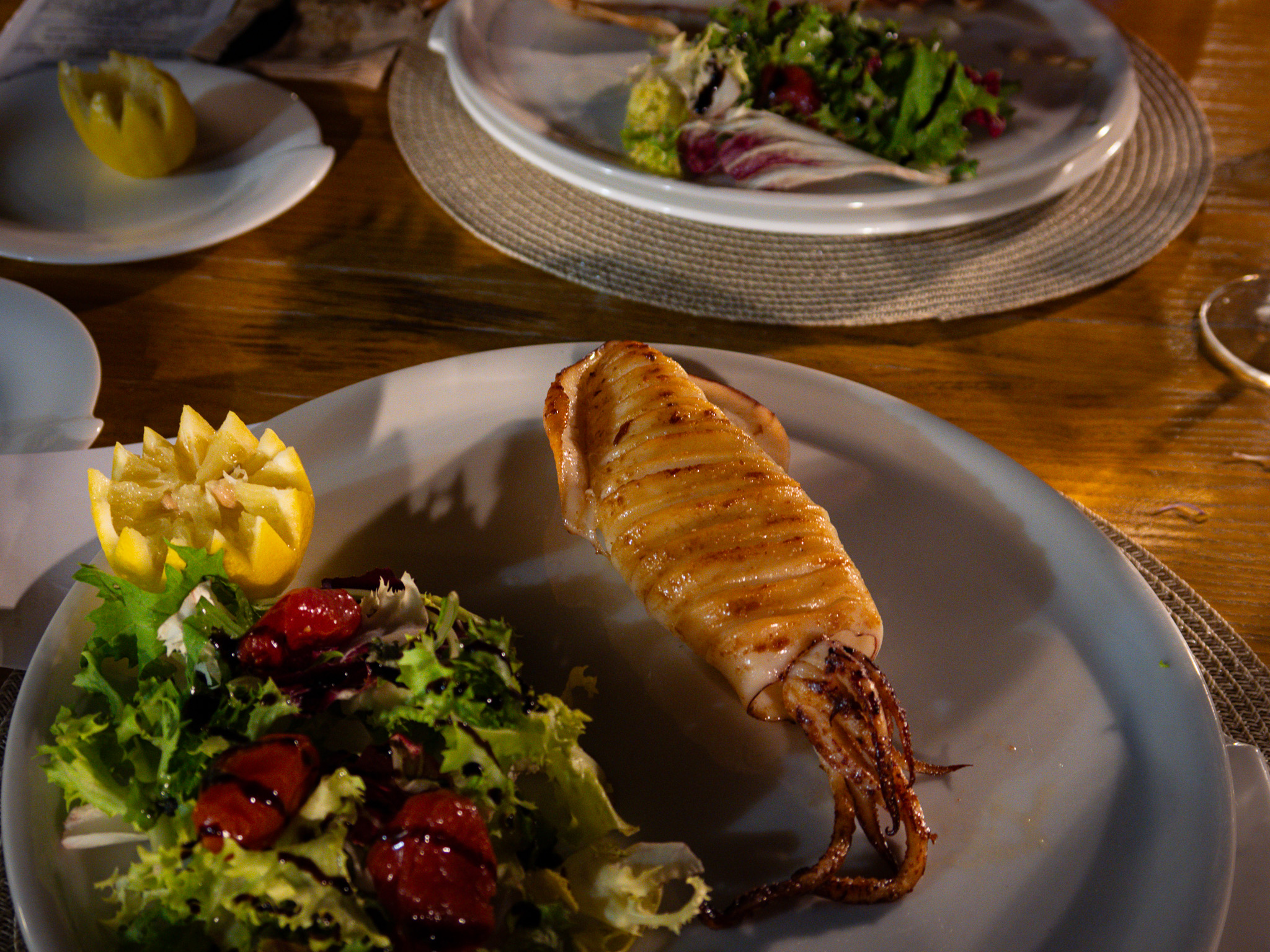
Day 2
We could see the mountains of the Sierra Espuña Regional Park from our hotel room in the morning. We packed our rain jackets and sufficient food, as our route on day two included 1,130m of climbing and 52km, with a forecast for heavy rain in the afternoon. About 9km into our ride we hit the first of many glorious trails, nestled in between an extensive pine tree forest. While the air was warm and dry, the mountains were super pleasant to cycle. Hard to imagine that this was once nothing but a barren desert. It was Ricardo Codorníu, a forestry engineer and ecologist, who started reforesting the area in 1889, which earned him the title ‘apostle of the tree’. After a quick stop in the visitor centre, named after him, we continued our journey, thankfully without any of the forecasted rain. We topped another amazing day on the bike with a visit to the hotel pool, looking at the mountains we had just explored on two wheels.

Day 3
Breakfast in the morning of day three was an omelette and bruschetta toast, served with a strong black coffee. Soon after we joined the hiking and cycling route between Totana and Caravaca de la Cruz, which connects the ends of the Campo de Cartagena Greenway and the Noroeste Greenway, which would be our route on day 4. Today’s cycle mostly followed the signposted route, crossed a vast territory full of environmental, scenic and cultural diversity. But it was the last section, about 10kms from the holy city, that really blew our minds. All the sudden we found ourselves in a steep sided gorge, and to our astonishment, with a river which was not dry, but carried water, a novelty on the trip so far.

This was Cueva Negra (Black Cave). Apart from the stunning natural beauty its real importance lies in the discovery of two bones and six human teeth, probably from the Heidelberg Man (Homo heidelbergensis), who appears to be the direct precursor of Neanderthal Man.
The last stretch into Caravaca de la Cruz was equally stunning, riding on champagne gravel through expansive fields. Ahead of us was the holy city, our view dominated by the Basilica of Vera Cruz, which houses the Cross of Caravaca, a relic that, according to Christian tradition, is believed to be a fragment of the True Cross.
Talking to the local mayor we learned more about the celebration of Horses of Wine, now listed as an Intangible Cultural Heritage of Humanity by UNESCO. Each year in May the tradition culminates in a race on 2 May, where elaborately dressed horses are run uphill by four men who must hold on throughout the race. Walking the quiet streets of the beautiful town and enjoying another fabulous meal was probably the perfect antidote to this rather dangerously looking spectacle.

the final push
The next morning, we met our guide for the day at the Almunia Hotel, who accompanied us on the next 100km, mostly on the Noroeste Greenway, into Murcia. Jose, who had helped me plan the route, is the local IMBA (International Mountain Biking Association) representative, and organises tours with his company The Osados, on the route. I bet no one knows the greenway better than him, and he was happy to share his local knowledge with us. The riding was different from the previous days, with more towns and villages along the former railway line, which all invited for a stop. While Louise’s battery life was a concern on the first day, today we ended up with plenty of life left when we arrived at the Occidental Murcia Agalia, our final accommodation in Murcia.
While so far we had followed Jose’s suggestions, we scoped out a route from Murcia to Cartagena and took the train back to our hotel. In comparison to the previous four days we had just spent in the saddle, the 75km-route to the train station was less exciting. Our train fare back was 6 Euro, and we agreed that the first section in the El Valle y Carrascoy Regional Park was far more beautiful than the remainder of the route.
To top off an amazing cycling holiday, I added on a loop in the mountains of the El Valle y Carrascoy Regional Park, which was about 30km long, when we returned to the hotel, while Louise made the most of the rooftop pool. And both of us were happy with what turned out to be one of the best bikepacking trips we had together.

Helpful links
More information about the region of Murcia can be found at www.turismoregiondemurcia.es
For guided trips, you can contact Jose from The Osados at www.theosados.com
Thinking of planning bikepacking trip? Check out Markus’ bike packing adventure guide here!

